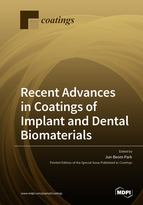Recent Advances in Coatings of Implant and Dental Biomaterials
A special issue of Coatings (ISSN 2079-6412). This special issue belongs to the section "Surface Coatings for Biomedicine and Bioengineering".
Deadline for manuscript submissions: closed (30 June 2022) | Viewed by 25167
Special Issue Editor
Interests: bone; bone biology; tissue engineering; stem cells; instrumentation; enzyme kinetics; bone regeneration; dental implants; biomaterials; oral health
Special Issues, Collections and Topics in MDPI journals
Special Issue Information
Dear Colleagues,
Recently, the development of coatings of the implant and bone surfaces has had great interest. The coating of implants may enhance enhance osseointegration. Moreover, coating the surface of implants may provide antimicrobial effects. Various methods/techniques can be applied for coating implant surfaces. Plama splaying and electrospraying have been developed as coating methods. Quite a lot of materials have been applied for implant coatings. Growth factors have been used, along with bioactive glasses and ceramics. Similarly, bone surfaces have been coated using various methods to enhance the functionality of the graft material.
This scope of this Special Issue will serve as a forum for papers in the following concepts:
- Theoretical and experimental research, knowledge, and new ideas in coatings of implant and bone surfaces;
- Recent developments in coating techniques;
- Recent developments in materials for surface coating;
- Understanding the mechanisms for enhanced functionality;
- Clincial research regarding the application of coated implant and/or bone.
Prof. Dr. Jun-Beom Park
Guest Editor
Manuscript Submission Information
Manuscripts should be submitted online at www.mdpi.com by registering and logging in to this website. Once you are registered, click here to go to the submission form. Manuscripts can be submitted until the deadline. All submissions that pass pre-check are peer-reviewed. Accepted papers will be published continuously in the journal (as soon as accepted) and will be listed together on the special issue website. Research articles, review articles as well as short communications are invited. For planned papers, a title and short abstract (about 100 words) can be sent to the Editorial Office for announcement on this website.
Submitted manuscripts should not have been published previously, nor be under consideration for publication elsewhere (except conference proceedings papers). All manuscripts are thoroughly refereed through a single-blind peer-review process. A guide for authors and other relevant information for submission of manuscripts is available on the Instructions for Authors page. Coatings is an international peer-reviewed open access monthly journal published by MDPI.
Please visit the Instructions for Authors page before submitting a manuscript. The Article Processing Charge (APC) for publication in this open access journal is 2600 CHF (Swiss Francs). Submitted papers should be well formatted and use good English. Authors may use MDPI's English editing service prior to publication or during author revisions.
Keywords
- Implant surface coating
- Bone surface coating
- Dental bioceramics coating
- Calcium silicate-based materials coating
- Recent advances in coating
- Mechanisms for coating
- Clinical research regarding coating






